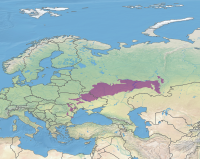
Photo from wikipedia
Climate change poses a considerable threat to the forest-steppe ecotone in arid mountain areas. However, it remains unclear how the forest-steppe ecotone responds to climate change due to the limitation… Click to show full abstract
Climate change poses a considerable threat to the forest-steppe ecotone in arid mountain areas. However, it remains unclear how the forest-steppe ecotone responds to climate change due to the limitation of the traditional pollen assemblages, which greatly limits the understanding of the history of the forest-steppe ecotone. Here, we examined the Tien Mountains, the largest mountain system in the world’s arid regions, as a case study to explore the migration of the forest-steppe ecotone using the pollen taxa diversity, by combining modern vegetation surveys, topsoil pollen and two fossil pollen sequences—in the mid-elevation forest belt (Sayram Lake) and in the low-elevation desert belt (Aibi Lake). We found that the forest-steppe migration followed Holocene climate change. Specifically, the forest belt where Picea schrenkiana Fisch. & C.A.Mey. dominates has a very low pollen taxa diversity, characterized by high richness and low evenness, which plays a key role in mountainous diversity. By detecting the diversity change of the deposition sites, we found that in coping with the warm and wet middle Holocene, the forest belt expanded and widened as the observed diversities around the two lakes were very low, thus the forest-steppe ecotone moved downward accordingly. During the early and late Holocene, the forest belt and the forest-steppe ecotone moved upward under a warm and dry climate, and downward under a cold and wet climate, as there was a reduced forest belt effect on, or contribution to, the sites, and the observed diversities were high. Moisture loss may pose the greatest threat to the narrow forest-steppe ecotone, considering the climatic niche space and the limited living space for humidity-sensitive taxa. This study highlights that temperature and moisture co-influence the forest belt change, which further determines the position migration of the forest-steppe ecotone.
Journal Title: Forests
Year Published: 2020
Link to full text (if available)
Share on Social Media: Sign Up to like & get
recommendations!